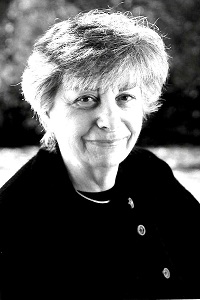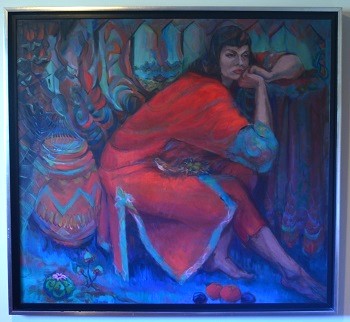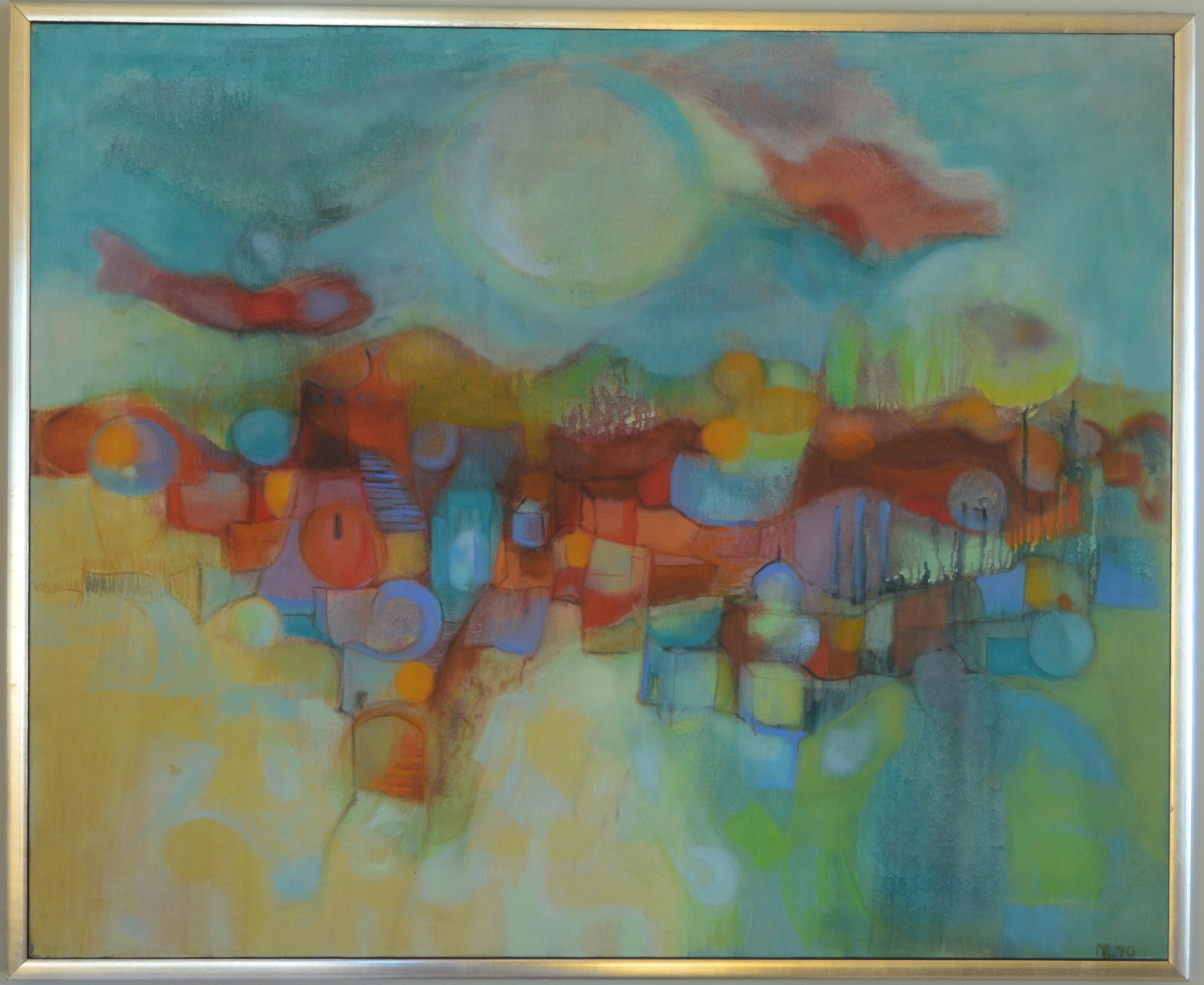By the time Marianne Lieberman came to UNC Charlotte to pursue a Bachelor of Creative Arts, she had already faced enough challenges, had enough adventures, and endured enough traumas for three lifetimes. And not just because she was a student in her 40s among a cohort of 20-somethings.

“When I was 11 years old, Hitler took over Austria, which automatically changed my whole life,” she would later recount in an oral history interview with J. Murrey Atkins Library Special Collections. “You could say I lost my identity overnight.”
Lieberman’s mother was Catholic, so she was categorized as a “Mischling” – mixed Jewish and non-Jewish. Her father left Austria, and for the next nine years, Lieberman and her mother both suffered and miraculously survived the persecution, violence, and deprivation of the Holocaust and World War II and their aftermath. In the midst of the fear and grief, Lieberman found solace in her art.
“My love was drawing – it had always been drawing – and that’s how I retained my equilibrium,” she said in her interview.
Lieberman died in 2021, leaving behind an extraordinary legacy as an artist and an activist. Following her death, her children, Miriam and Larry Lieberman, donated 30 of their mother’s artworks to the Mint Museum of Art, recognizing the long association she had had with the museum. Last January, the Mint Uptown mounted an exhibition of the work, Feeding the Stone, which is on view indefinitely.
Making Sense of Her World
When Marianne Lieberman and her mother joined her father in New York in 1947, she had had very little formal art education. She became a pattern maker in the garment industry and “went to every available class of art that I could afford to pay for myself,” she later recounted. In the next five years, she married, started a family, and moved to Charlotte, where she soon began to take art classes at the Mint. She would spend the next two decades nurturing her children and her talents, negotiating the demands of the home with those of the studio – a topic that sometimes emerged in her art. (Pictured right, "The Artist as Mother.")
“I learned who I was by painting,” she said.
 In 1973, Lieberman entered the Bachelor of Creative Arts (BCA) program at UNC Charlotte with a range of artistic skills and an impressive body of work that had been exhibited in local shows. What the open and interdisciplinary curriculum offered her was the opportunity to read widely and the space to dig more fully into both her own personal history and the contemporary world around her. The art she produced, her daughter Miriam said recently, “was a result of what she was reading and studying,” including “a lot of mythology,” psychology, and books by the poet and classicist Robert Graves, who would become a prominent inspiration for her. (At left, the lithograph "For Robert Graves.")
In 1973, Lieberman entered the Bachelor of Creative Arts (BCA) program at UNC Charlotte with a range of artistic skills and an impressive body of work that had been exhibited in local shows. What the open and interdisciplinary curriculum offered her was the opportunity to read widely and the space to dig more fully into both her own personal history and the contemporary world around her. The art she produced, her daughter Miriam said recently, “was a result of what she was reading and studying,” including “a lot of mythology,” psychology, and books by the poet and classicist Robert Graves, who would become a prominent inspiration for her. (At left, the lithograph "For Robert Graves.")
With the effort to ratify the Equal Rights Amendment in 1972 and the passage of Roe v. Wade in 1973, Lieberman also became vigorously engaged with the feminist movement, reading, for example, books by the feminist poet and essayist Adrienne Rich. With her husband Gerald, she founded the state affiliate of the National Abortion Rights Action League (NARAL). All of these topics found a place in her work.
“It was through her art that she tried to make sense of the world,” said Miriam Lieberman.
The Demand of the Stone
Several of those pieces made while a student at UNC Charlotte are now in the Mint collection and on view at the uptown location. They are lithographs, the medium that Lieberman “thought were her best work,” said her daughter. Lithography is a process of printing from a drawing etched on a stone. Lieberman had first learned lithography in a summer program in San Miguel de Allende, Mexico, where she studied for several summers at the Instituto Allende -- sometimes with children in tow. Lithography became, she later said, “a magical thing” for her.
“To work on the stone is a totally entrancing experience…lithography is really the expression that I find is most demanding, and allows me to be spontaneous, because that’s the demand of the stone, in my opinion. And the stone works with the artist.”
While she was at UNC Charlotte, Liebermann became connected, through the recommendation of professor Martha Strawn (now retired), with Penland School of Craft in the mountains of North Carolina, where she continued her lithography training. Her graduating exhibition was held at The Light Factory – two rooms of photography, drawings, etchings, and lithography.
“I was very elated to have been able to do all that work and have this exhibit,” Lieberman later described. “It was a milestone in my life.”
Three prints from Lieberman's studies at UNC Charlotte, on view at the Mint Museum of Art in uptown Charlotte. Left to right: "The Last Illegal Abortion," "Penelope and the Maidens," and "Die Amme" ("The Wet Nurse"). They represent the themes she pursued as a student: women's rights, Classical mythology, and her own personal history.
Strawn, who remained friends with Lieberman long after her graduation, said in a recent interview that Lieberman brought so much to the BCA program and her fellow students.
“In that group environment (fostered by the BCA curriculum), you really learn from each other so much, from working on projects together. Marianne really contributed to other students who were so much younger.”
Strawn said that Lieberman’s difficult youth instilled great courage in her, which emerged in her art.
“Marianne was so focused on how people were treated, how humanity was treated, how women were treated. She put her full heart and conscience in her work. She didn’t back down.”
But while she was “a fighter,” Strawn added, Lieberman also “had a grace and elegance about her,” that was as strong as her integrity.
“Hopefully I learned some grace from her.”
Lieberman's painting, "Utopia," from 1970. Although Lieberman admired her lithography most, "I actually love the paintings," said her daughter, Miriam. At top, the lithograph "Symbiotic Relationship" from 1980.
All quotes from Marianne Lieberman are from her oral history interview, conducted by Jennifer Greeson on June 29, 1993, and archived in the J. Murrey Atkins Library Special Collections. Also in Special Collections is an inscribed copy of Lieberman’s memoir, Aftershocks (2014), which includes samples of her paintings, drawings, etchings, and lithographs.


